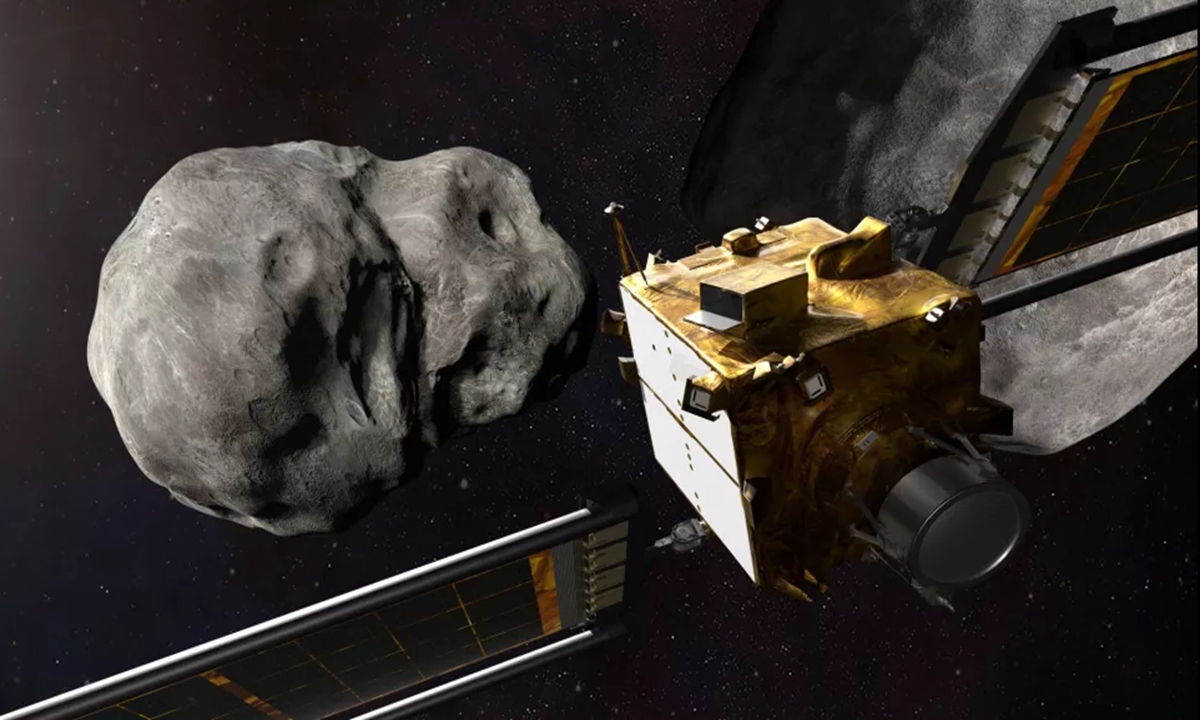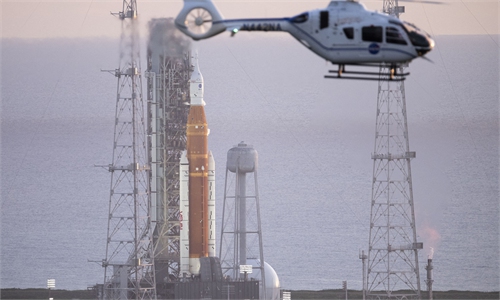Chinese space watchers wish best of luck to NASA’s asteroid crash mission, the first planetary defense endeavor

An artist's depiction of the DART spacecraft approaching the asteroid Dimorphos. Screenshot from space.com
Chinese space watchers wished on Monday the best luck for NASA's upcoming ambitious Double Asteroid Redirection Test (DART) asteroid crash mission, saying that if successful, it would mark a first victory in human's planetary defense endeavor which carries great significance for mankind's survival.
Coming amid the multiple delays of the Artemis I mission; NASA's DART asteroid crash is designed to slam a spacecraft into the tiny moon of the asteroid Didymos on 7:14 pm US EDT Monday. If all goes well, the spacecraft will hit the moonlet called Dimorphos, and snap images until the moment of impact.
It will be mankind's first-ever asteroid defense experiment and also a first for human to attempt to change the orbit of an asteroid via a crash mission.
Elena Adams, DART's lead mission systems engineer at Johns Hopkins University Applied Physics Laboratory, said there is a 91 to 99 percent chance of a successful impact if DART's cameras can see Dimorphos.
Such event reminds many on Earth of the 2021 Netflix blockbuster Don't Look Up, an apocalyptic political satire black comedy film in which two astronomers attempted to warn humanity about an approaching comet that will destroy human civilization but failed in the end. However, DART's target of the hit and deflect mission is a non-hazardous one.
Still it will also be the start of masses of new data in what scientists call "planetary defense," media reported.
It is a very meaningful experiment, Pang Zhihao, a senior space expert based in Beijing, told the Global Times on Monday. "Mankind have been forming multiple kinds of planetary defense strategy, but it is a first experiment to be put in practice."
Besides, the crash mission would renew our knowledge of asteroid which contains highly valuable minerals such as platinum and even amino acids that could help explain the complex origin of life form in space, Huang Zhicheng, a Chinese expert in aerospace science and technology, told the Global Times on Monday.
To illustrate the threat of an asteroid impact, Huang cited the case of the Chelyabinsk meteor incident, where the small asteroid broke up over the city of Chelyabinsk, Russia, on February 15, 2013 and the shock wave it generated shattered glass and injured about 1,200 people, to be a wake-up call for mankind.
NASA's DART mission was launched on November 24, 2021. DART's target Dimorphos is about 170 meters wide and orbits its larger parent Didymos once every 11 hours and 55 minutes. The asteroids are about 9.6 million kilometers from Earth and pose no risk of impacting our planet, NASA has said. DART is supposed to hit Dimorphos while traveling at about 14,760 meters per hour, according to the US industry website Space.com.
"We have to view the matter from a higher standpoint, as it represents not only the US' technology advancement, but also that of all human civilization. The threat from a disastrous asteroid impact we are facing is a real one and we must mobilize to explore technology to intercept them or conduct early warning, among others purposes," Song Zhongping, a space watcher and TV commentator, told the Global Times.
Compared with the colonialism colored Artemis deep space mission which proves to be a rushed work and therefore meets repeated frustrations in the inaugural launch mission, NASA should invest more in the causes that are for the interests of a shared future for all, observers noted.
NASA has announced that it will not attempt to launch the Artemis I moon mission on Tuesday due to the impacts of Tropical Storm Ian, which is expected to reach Florida as a major hurricane early next week. And previously, NASA has scrubbed the launch twice.
China, as a rising space power, is also making preparations for planetary defense capability.
According to Wu Yanhua, deputy head of China National Space Administration in April, China is getting ready to build a near-Earth asteroid defense system. And by the end of 14th Five Year Plan period (2021-25) or somewhere between 2025 and 26, China could be attempting its own asteroid crash mission in order to test human's asteroid deflecting capability and to avoid asteroid impact.
Such system will comprise a near-Earth asteroid monitoring and defense system to deal with the threat of asteroid impacting on spacecraft, and contribute to protecting the safety of the Earth and mankind, according to Wu.
A ground-based and space-based monitoring and warning system for asteroids will be set up to catalog and analyze asteroids that pose a threat to humanity's space activities, and then relevant technology and engineering will be developed to dispel the threats.
Mission insiders revealed to the Global Times in April that the system is currently at the project establishment phase and being reviewed for approval, which involves the close coordination of multiple departments.
China has also recently begun constructing a new high-definition deep-space active observation facility in the country's Chongqing Municipality, with goals including boosting its defense capability against near-Earth asteroid as well as sensing capability for the Earth-Moon system.
The new observation facility, codenamed China Fuyan [facetted eye], will be consisted of distributed radars with more than 20 antennas, and each antenna will have a diameter of 25 to 30 meters. Working together, they are expected to carry out high-definition observation of asteroids within 150 million kilometers, the Global Times learned from the project lead, the Beijing Institute of Technology.
Pang said that China is moving toward the goal in a well-paced fashion. Compared to the NASA mature asteroid probe experiences, China needs to first carry out orbit, landing and sample returning missions to an asteroid before carrying out crash attempts.
Zhang Rongqiao, the chief designer of Tianwen-1 Mars probe mission, revealed to the media in May that Tianwen-2 has entered its prototype research and development stage, and it is expected to be launched by 2025.
Tianwen-2 will be a decade-long mission, during which the probe will carry out observations and return samples from near-Earth asteroid 2016HO3. According to Space.com, the target asteroid is also named Kamo'oalewa, which may actually be a blasted-off piece of Earth's moon.
In fact, China's Chang'e-2 lunar mission has conducted a flyby probe to the asteroid Toutatis, which marked that China has become the fourth to achieve the feat, following the US, Europe and Japan.


